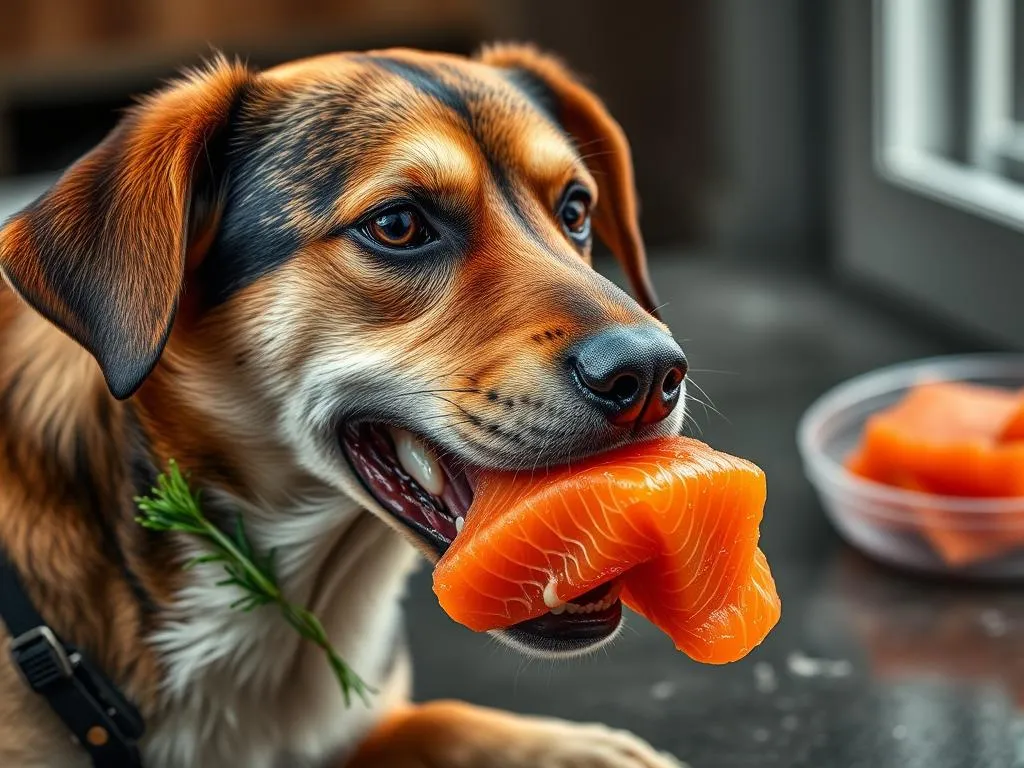
Introduction
Dog nutrition is a crucial aspect of pet ownership, impacting not only a dog’s health but also its overall quality of life. Dogs require a balanced diet that meets their specific nutritional needs, which can vary based on factors such as age, breed, and health status. One food that often raises questions among dog owners is salmon, particularly in its raw form. This article delves into the nutritional value of salmon, the potential risks of feeding dogs raw salmon, and safer alternatives that can contribute to a dog’s well-being.
Understanding Dog Nutrition
Basic Nutritional Needs of Dogs
To understand whether dogs can eat raw salmon, it’s essential to grasp the basic nutritional needs of dogs. Dogs require three primary macronutrients:
- Proteins: These are the building blocks for muscle, skin, and tissues. Proteins are vital for growth, maintenance, and overall health.
- Fats: Healthy fats provide energy and help in the absorption of fat-soluble vitamins. They also contribute to a shiny coat and healthy skin.
- Carbohydrates: While dogs are primarily carnivorous, carbohydrates can provide energy and support digestive health.
In addition to macronutrients, dogs also need a variety of micronutrients, including vitamins and minerals, which play vital roles in numerous bodily functions.
Common Dog Dietary Requirements
Dietary needs can vary significantly among dogs:
- Puppies: Require higher protein levels for growth and development.
- Adults: Need a balanced diet to maintain health and energy levels.
- Seniors: May require fewer calories but more fiber, vitamins, and minerals to support aging processes.
Additionally, certain breeds may have specific dietary needs, such as larger breeds requiring certain nutrients to support joint health.
Nutritional Value of Salmon
Essential Nutrients in Salmon
Salmon is often hailed for its impressive nutritional profile, making it a popular choice among dog owners looking to enhance their pet’s diet. Here are some of the key nutrients found in salmon:
- Proteins: Salmon is rich in high-quality protein, essential for maintaining muscle mass and overall health.
- Omega-3 Fatty Acids: These beneficial fats support skin, coat, and heart health, and can help reduce inflammation.
- Vitamins and Minerals: Salmon is a good source of essential vitamins such as B12 and D, which are crucial for energy metabolism and bone health.
Comparison of Raw vs. Cooked Salmon
When considering whether dogs can eat raw salmon, it’s important to examine the differences between raw and cooked salmon:
- Nutritional Differences: Cooking salmon can reduce some of the vitamins and omega-3 fatty acids. However, it also eliminates harmful bacteria and parasites that could pose risks to dogs.
- Benefits and Drawbacks: Raw salmon retains its natural oils and nutrients but carries the risk of contamination. Cooked salmon is safer but may lose some nutritional value.
Can Dogs Eat Raw Salmon?
Health Risks of Feeding Raw Salmon
While salmon can be a nutritious addition to a dog’s diet, there are significant health risks associated with feeding raw salmon:
- Parasitic Infections: Raw salmon can harbor parasites such as Neorickettsia helminthoeca, which can lead to a serious condition known as salmon poisoning disease. This disease can be fatal if not treated promptly.
- Bacterial Contamination: Raw salmon may carry harmful bacteria, including Salmonella and Listeria, which can cause severe gastrointestinal issues in dogs.
- Symptoms of Illness: Dogs that consume raw fish may exhibit symptoms such as vomiting, diarrhea, lethargy, or loss of appetite.
When Feeding Raw Salmon May Be Safe
In certain situations, feeding raw salmon might be considered safe. However, several precautions should be taken:
- Sourcing: It is crucial to source salmon from reputable suppliers who provide fish that is specifically processed for raw feeding.
- Handling and Preparation: Proper handling techniques must be followed to minimize contamination risks. This includes maintaining hygiene and storing the fish correctly.
- Consulting a Veterinarian: Before introducing raw salmon into your dog’s diet, it’s best to consult a veterinarian, especially if your dog has a pre-existing health condition.
Alternatives to Raw Salmon
Cooked Salmon Options
For those who wish to include salmon in their dog’s diet without the risks associated with raw fish, cooked salmon is a great alternative.
- Benefits of Cooking: Cooking salmon eliminates harmful bacteria and parasites while retaining many of its nutritional benefits. It is a safer option that still provides the essential nutrients dogs need.
- Simple Cooking Methods: Baking or grilling salmon is easy and retains most of its nutrients. Avoid using seasonings, and ensure that bones are removed before feeding it to your dog.
Other Fish and Protein Sources
If you’re looking for additional nutritional options for your dog, consider these alternatives:
- Other Safe Fish Options: Cooked sardines and tilapia are excellent alternatives that provide similar nutritional benefits without the risks associated with raw salmon.
- Alternative Protein Sources: Chicken, beef, and lamb are also nutritious options that can be included in your dog’s diet. Make sure to prepare these meats safely and without harmful additives.
How to Incorporate Salmon into a Dog’s Diet
Portion Sizes and Frequency
When incorporating salmon into your dog’s diet, it’s essential to pay attention to portion sizes:
- Recommended Portion Sizes: Generally, a small dog can be fed about a quarter of a fillet, while larger breeds can handle a whole fillet. Adjusting the portions based on your dog’s size and weight is crucial.
- Frequency of Inclusion: Salmon can be offered as an occasional treat or integrated into meals once or twice a week, depending on your dog’s overall diet and health.
Signs of Allergies or Sensitivities
When introducing any new food, including salmon, it’s important to monitor your dog for signs of allergies or sensitivities:
- Common Signs of Food Allergies: Symptoms may include itching, skin irritations, gastrointestinal upset, or changes in behavior.
- What to Do if Adverse Reactions Occur: If you observe any negative reactions after feeding your dog salmon, discontinue feeding it immediately and consult your veterinarian for guidance.
Conclusion
In summary, while raw salmon can be a nutritious option for dogs, the associated health risks often outweigh the benefits. Cooked salmon provides a safer alternative that still delivers essential nutrients without the danger of parasites or harmful bacteria. Always consult with a veterinarian before making any significant changes to your dog’s diet, and ensure that any fish you provide is prepared safely. By understanding the nutritional value of salmon and adhering to safe feeding practices, you can enhance your dog’s diet while keeping their health in check.
FAQs
Can all dogs eat salmon?
Not all dogs may tolerate salmon well. It’s essential to observe for allergies and consult a veterinarian.
What should I do if my dog eats raw salmon?
If your dog consumes raw salmon, monitor for symptoms of illness and consult your veterinarian, especially if any adverse reactions occur.
Are there any fish that dogs should avoid?
Certain fish, like raw tuna and mackerel, should be avoided due to high mercury levels and potential toxins.
How should I prepare salmon for my dog?
Cook salmon by baking or grilling without any seasoning, ensuring all bones are removed, to provide a safe and nutritious treat.
Understanding your dog’s nutritional needs is key to ensuring a healthy and happy life. Always prioritize safety and health when considering new dietary additions, and consult with your veterinarian for tailored advice.









